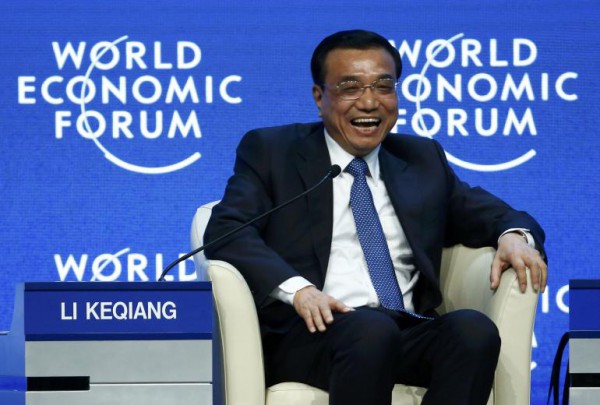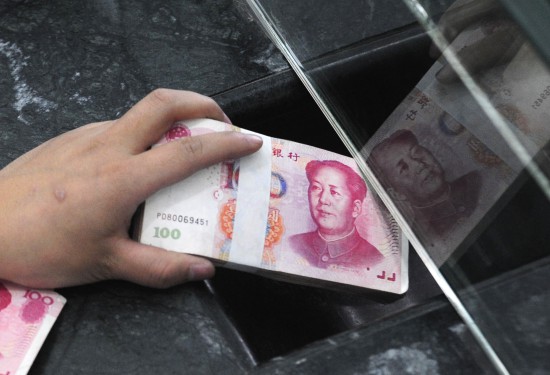China’s leaders in tough balancing act between growing debt mountain and falling growth rate
chinaworker.info
China’s central bank (PBOC) announced on Wednesday 4 February a half percentage point cut in banks’ reserve requirement ratio (RRR) in a move to add liquidity to a slowing economy. The change reduces the amount of deposits that each bank is required to hold as reserves, from 20 to 19.5 percent. The effect of this, according to the Financial Times, is equivalent to an injection onto banks’ balance sheets of 600 billion yuan (US$96 billion). Economic commentators are forecasting further such moves to ease credit conditions in coming months. China’s economy grew at its slowest pace in 24 years in 2014, with gross domestic product (GDP) increasing 7.4 percent.
The central bank’s move underlines the difficulties now facing the world’s second biggest economy and the Chinese (CCP) dictatorship as it grapples with an unprecedentedly rapid debt run-up following huge stimulus measures used to finance a construction blitz from 2009 to 2013. China’s debt-to-GDP ratio rose from 147 percent in 2008 to 251 percent last year, with corporate debt responsible for almost two-thirds of this increase. While most advanced capitalist economies have bigger debt-to-GDP ratios these were accumulated over many decades. In China it is the speed with which debt has grown that has led many economists to warn of a financial crisis. China’s debt-to-GDP ratio is the highest among large developing countries. Despite a crackdown by Beijing on the riskiest forms of shadow banking, total social financing (aggregate credit) increased by 14.5 percent in 2014 and some forms of shadow bank lending increased rapidly even as others were reined in.
Japanese scenario?
The PBOC action matches similar policies by more than a dozen central banks to ease monetary policy in the first weeks of 2015. The economic strategists of capitalism – if they can be called such – are increasingly alarmed by plummeting commodity prices and the spread of deflation (falling prices). Many are now warning that the dominant sectors of the world economy, and this includes China, are heading into a Japanese-style deflationary crisis with depressed economic conditions for many years or even decades.
In China’s case there are new warning signs as the property slump intensifies and industry struggles with overcapacity on a scale never before seen. Industrial profits have fallen 8 percent in the past year, while factory prices – squeezed by overcapacity and a price-cutting war – have fallen continuously for the past 34 months. Fresh data today (HSBC Services Purchasing Manager’s Index) shows that China’s services sector grew at the slowest pace in six months in January, as new business starts tapered off. The services sector is where most new jobs are created and this is where the Chinese regime has pinned its hopes on avoiding a spike in urban unemployment levels that could trigger social unrest.
‘New normal’
These developments contradict the cheery message that Premier Li Keqiang delivered at the World Economic Forum in Davos last month. He told the elite gathering that China’s economy was not heading for a hard landing and repeated the now familiar mantra that slowing growth is a welcome ‘new normal’. Li’s mission, not entirely successful, was to extinguish any outbreak of nervousness among foreign governments and capitalist leaders over China’s economic wobbles.
Fears are being expressed, even unusually by the China-friendly IMF, that the housing sector slump is more serious than recognised and that risks are increasing of corporate defaults that could trigger a banking crisis. Beijing is attempting to disarm this bomb in part by covering up the true scale of bad loans within the state-owned banking system and also by attempting to ‘manage’ some localised and selective defaults, set to rise in the course of this year. The government is opening new sources of capital for example by stoking a stock market boom, and increasing bond sales by some local governments, to reduce the exposure of the banks to a potential wave of defaults. This is the equivalent of shuffling toxic waste from one part of the financial system to another. Regime strategists hope in this way to buy time so that the economy can grow its way out of the current debt crisis. That’s the theory, as they say. But with China’s GDP growth on a downward trajectory and global capitalism in a historic dead-end crisis this ‘theory’ will be put to a savage test.

Capital outflows
The latest central bank action, while not unexpected, is another sign that things are worse than Li and other top leaders are prepared to admit. As for other central banks and governments, the spectre of deflation is now a major concern in China. The cost of loans is increasing in real terms as inflation rates flatten or fall into negative territory. For economies that have built up massive levels of debt this threatens defaults, and possible banking crises.
Another problem for Beijing is capital leaving due to the lack of lucrative new deals in China, especially with the downturn in the all-important property sector, and flowing overseas in search of higher rates of return. This is exacerbated by the policies of the US Federal Reserve (central bank) in calling a halt to its four-year ‘quantitative easing’ programme (money-printing) which in turn is pushing the dollar and US long-term interest rates upwards. In theory, government capital controls in China should block this capital outflow but in reality there are hundreds of ways for China’s millionaires and companies to get their money out.
Ding Shuang, senior China economist at Citigroup in Hong Kong, believes it is the capital outflow, which has drained liquidity from the banks, that is the main factor prompting the central bank’s rate cut. On Tuesday 3 February, the State Administration of Foreign Exchange (SAFE) reported that capital outflow in the final quarter of 2014 was the largest since 1998.
Partly in response to these pressures, to entice capital to stay at home, the Chinese regime has initiated a wave of speculation on the domestic stock markets. This has been encouraged by loosening regulation, including approval for high-risk so-called ‘umbrella trusts’ that facilitate stock market trades financed through high levels of borrowing, as well as exhortations in government controlled media to join the ‘niu shi’ (bull market). The Shanghai stock market surged 50 percent in the second half of 2014, with the central bank’s interest rate cut in November adding fuel to the fire. The stocks boom is unsustainable and absurd, especially with every other economic indicator pointing downwards. But then again, all stock markets are similarly irrational expressions of the greed and short-sightedness of capitalism.
The Chinese regime’s interest in stoking a stock market boom is to use this, and a planned stream of initial public offerings (for state-owned and private companies), as an alternative source of funding for the debt-laden corporate sector. This, it hopes, will help the government to deleverage the economy (reduce debt) while avoiding a recession and a wave of company failures. Beijing is trying to deflate one financial bubble by blowing up another.
As chinaworker.info has explained in other articles looking at the Chinese economy, the regime’s economic balancing act – using capitalist and increasingly neo-liberal policy tools – has a high risk of failure, with possibly serious consequences for the economy in the period ahead.
Also on China’s economy:
China’s GDP slowest since 1990 (23 January 2015)
China: Hard landing in 2015? (24 December 2014)




